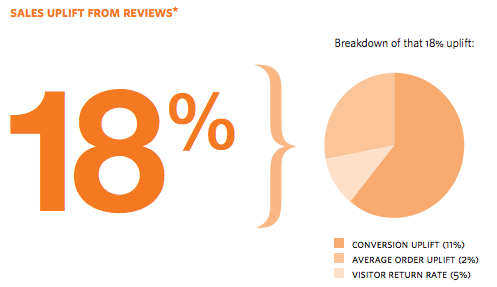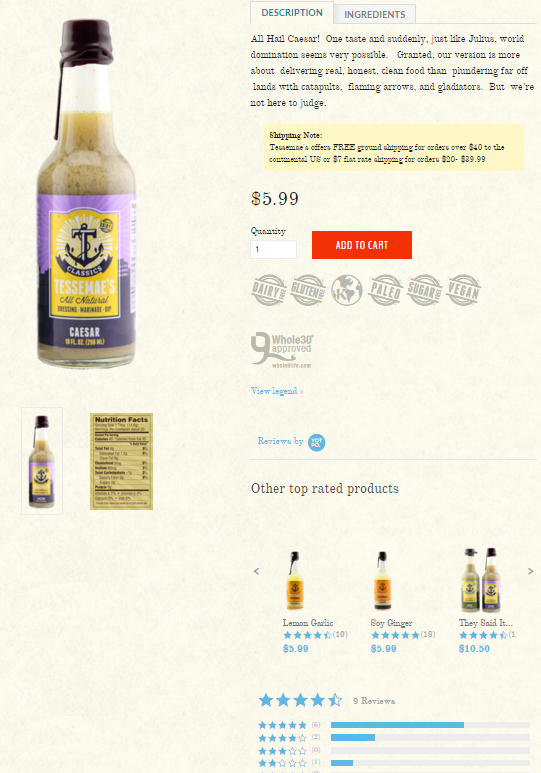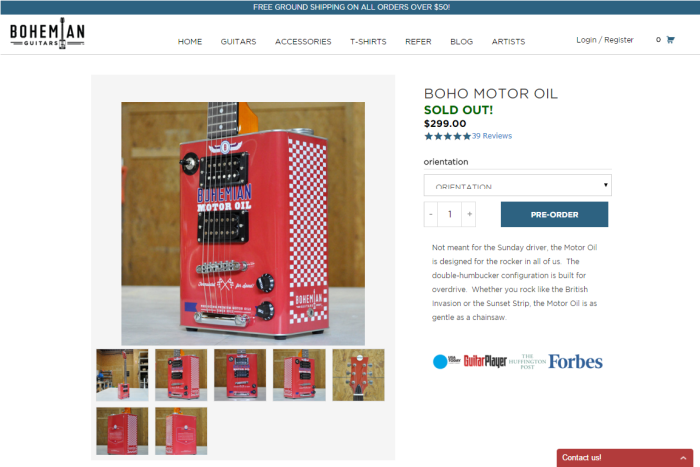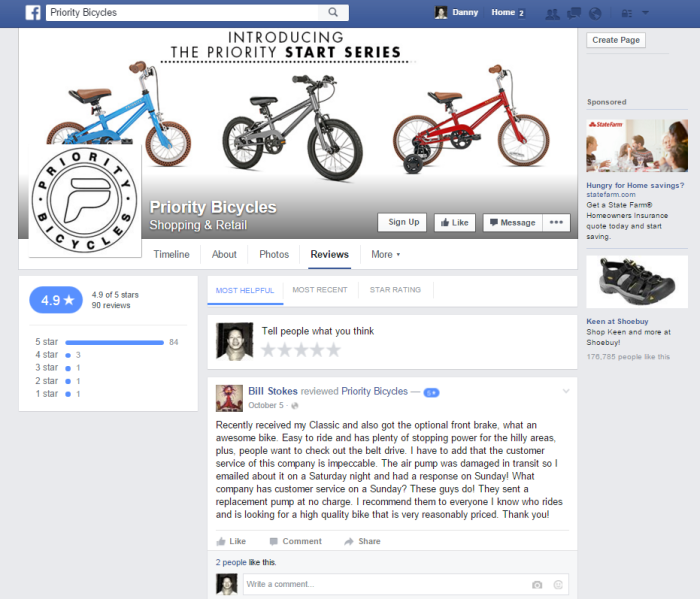A 3-Step Process to Generating Positive Product Ratings and Reviews for Ecommerce Businesses
Update November 2016: We now offer product reviews!
Ecommerce expert Omer Rachamim estimates there are between 12 and 24 million online stores around the globe. With so many stores, the options are endless for customers. And, for brands, that means competition is fierce. Consequently, standing out can be hard, especially when retailers in your niche may have a stronger brand name and offer similar products at more competitive prices.
Fortunately, one way stores can beat their rivals is by earning positive product ratings and reviews. With public feedback from customers, lesser known brands can convince first-time customers to give them a try. In fact, a widely cited study by Ipsos, a market research company, suggests 61% of shoppers read online reviews as part of their decision making process. And data from Reevoo, a customer ratings platform, reveals that strong reviews lead to an 18% uplift in sales. By harnessing the power of product ratings and reviews, Ecommerce companies can outearn their competitors and grow their bottom line.
But here’s the thing: Brands truly have to earn praise from happy customers. To do just that, companies must follow three simple rules:
- Produce an amazing product
- Create a memorable customer experience, then
- Ask them
1. Produce an amazing product
With a plethora of options, customers have become spoiled — and rightfully so.
Shoppers demand goods and services that are excellent, not mediocre. For their hard-earned dollar, they want a product that fulfills a “job” they need to accomplish. In an article for Harvard Business Review, Harvard Business School professor Clayton M. Christensen, Intuit’s founder and chairman Scott Cook, and Advertising Research Foundation’s former Chief Strategy Officer Taddy Hall explain, “[Marketers and brands focus] too much on creating products for narrow demographic segments rather than satisfying needs. Customers want to ‘hire’ a product to do a job, or, as legendary Harvard Business School marketing professor Theodore Levitt put it, ‘People don’t want to buy a quarter-inch drill. They want a quarter-inch hole!’” Rather than produce a product for a certain type of customer, stores should invent goods that offer specific solutions to customers’ biggest problems.
Through solution-driven design, Ecommerce stores create items customers will rave about. Christensen, Cook and Hall also note, “With few exceptions, every job people need or want to do has a social, a functional, and an emotional dimension. If marketers understand each of these dimensions, then they can design a product that’s precisely targeted to the job. In other words, the job, not the customer, is the fundamental unit of analysis for a marketer who hopes to develop products that customers will buy.”
A quality product is absolutely a prerequisite for companies that want positive customer reviews. And to have a brand that buyers will love talking about, stores must provide top-notch customer service.
2. Create a memorable customer experience
Customers want to be “wowed.” From the first moment they arrive at your site through until checkout, they expect you to sprinkle in fun, exciting and useful details and features to keep them engaged. That means, the images, videos, product descriptions, and FAQs should keep them toggling through different pages on your site until they find products they’ll want to purchase.
But your work doesn’t end after a buyer has checked out.
Post-purchase, stores have the opportunity to surprise and delight shoppers with personalized digital receipts, a stunning unboxing experience, and information that helps customers extract more value from your product. These, of course, are proactive measures Ecommerce companies can take to create a flawless shopper experience customers will regularly talk about.
When a hiccup occurs though, brands must learn how to be deliberate in their dealings with disappointed customers instead of reactive; stores can sully their reputation with just one hostile response to a customer. So, when a customer voices a complaint, stores should make it their mission to win that person back. To convert unhappy customers into brand advocates, Josh Brown recommends doing five things:
- Acknowledge customer complaints. Brown says, “Often times an unhappy customer actually cares more about just feeling like they’ve been understood.” Therefore, a timely and empathetic response is important.
- Accommodate their needs. After reflecting on why a customer was unhappy, find a solution that will put a smile on their face once again.
- Avoid a PR disaster and resolve issues quietly. When upset shoppers publicly air their grievances, brands ought to address customer concerns privately. Other consumers and the media have a bad habit of taking sides, which can unnecessarily escalate things.
- Build a brand people admire and love. Develop a track record for delivering exceptional customer service and for turning around angry customers.
- Actively improve. Customer complaints help brands uncover underlying issues with the how they do business. Stores may use those clues to permanently resolve problems that frequently cause customer dissatisfaction.
Finally, when customers are satisfied with the product they have purchased and the service they received, it is time for store owners to request an honest review.
3. Ask them
Unprompted, hundreds of positive opinions about your brand may go unheard.
Although your best customers already recommend your business and its products to their friends and family members, many rarely think about rating the items they have ordered or posting a formal review. Even if one of your most loyal customers refers a friend your way, that potential buyer will instinctively seek out further validation from strangers who have also tried out — and enjoyed — your products.
To encourage the right customers to publish a product review, Len Markidan of help desk software company Groove shares five tips:
- Ask customers who regularly use and value your product.
- Wait until the right moment, after a customer has had enough time to fully enjoy your offerings.
- Request an honest review, instead of coaching them into giving you a “good” or “positive” one.
- Resend unanswered requests.
- Respond to positive reviews with a quick ‘thanks’ to demonstrate your appreciation, and address negative reviews to show your commitment to building a better business.
On-site, stores can host persuasive and trustworthy reviews by using third-party ratings platforms such as Bazaarvoice, Feefo, LouderVoice, or Reevoo. To further increase the number of reviews you receive, stores may also direct customers to post feedback on reputable review sites. Among those are:
- Better Business Bureau (BBB)
- Consumer Reports
- Facebook (Ratings & Reviews)
- Google My Business
- Review Centre
- SiteJabber
- Trustpilot
- Yelp
And elsewhere around the web, Ecommerce businesses can earn product reviews when they partner with influential bloggers in their niche. By offering samples and items on loan, stores get their products into the hands of respected influencers who can then share their honest feedback about your offerings with their audience. These are especially powerful reviews because Adweek reports that for every dollar spent on influencer marketing, brands earn $6.85 in ROI.
Final thoughts
With ratings and reviews, more is better. Figures from Econsultancy and Reevoo suggest, “50 or more reviews per product can mean a 4.6% increase in conversion rates.” Therefore, companies that want to organically grow sales need to constantly find ways to get customers to share their opinions. Ultimately, for brands to consistently earn positive product ratings, they will need to repeat steps #1 through #3 over and over again, offering valuable products and engaging experiences shoppers will happily write a review about when prompted.
How does your store convince customers to share gushing customer reviews?
CM Commerce Reviews is included as part of our Premium plan





